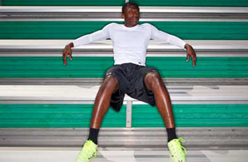This story appeared in the April 20 issue of ESPN The Magazine.
After finishing his final 40-yard dash attempt, Miami cornerback Bruce Johnson lets his momentum carry him to the far end of the Hurricanes' practice field. There, in the shadow of a parking garage, he glances back at the school's pro day setup. What he sees are the unmistakable signs of the end of an era. Aluminum bleachers, once bulging with 100 scouts reeking of rental-car living, are not even half full on this late-February afternoon. The large section roped off for agents contains only seven people, four of whom are university employees. In the nearly deserted area behind the end zone—which most years overflows with family, friends and students—a woman with her back to the field talks on her cell about her cousin's canine-allergy medication. The VIPs, once a who's who of NFL royalty, are limited to a pair of big-name former Canes: Panthers linebacker Jon Beason and Cardinals running back Edgerrin James, who wrapped Johnson in a hug before the day began and implored him to "represent the U."
As Miami's best pro prospect, Johnson, 22, does in fact perfectly embody the state of the Hurricanes, who have gone 12—13 since 2007. Undersized (5'9") and a step slow (40 time: 4.42), the soft-spoken Johnson is ranked as the draft's 25th-best corner by Scouts Inc. and will likely be a late-round pick. That means that for the first time since 1994, the program dubbed NFLU won't have a player taken in the first round, ending a streak that changed both college and pro football. The last year a Hurricane wasn't selected in one of the first three rounds? Try 1986. "I guess it's kind of a sad day," Johnson says after his workout.
In many ways, Miami is a victim of its own success—it became so good at producing NFL players that everyone stole the school's formula. Dennis Erickson, who took over for Jimmy Johnson, cranked up the pipeline while winning national titles in 1989 and 1991. The coach wooed players to his program by promising what they really wanted: a paved path to the pros. Unlike most college teams then, Miami became NFL-friendly, giving scouts ample access to game film, prospects and facilities.
That open attitude most noticeably manifested itself in a souped-up pro day that had the intensity of a bowl game and the star power of South Beach. While the Canes performed the same drills and underwent the same measurements as prospects elsewhere, they did them in front of stands packed with family, recruits and ex-players. The day was a can't-miss event rather than an obligatory exercise. Allured by the hoopla and wealth of talent, all 32 NFL teams sent their GM, their coach or often both, and a few dispatched up to seven scouts. "It was like a festival, a celebration," says Titans GM Mike Reinfeldt. "You knew there'd be so many good players you might discover someone you weren't even looking for."
The results are staggering. Over the past 14 years, Miami produced more first-round picks (33) than any other school, beginning with defensive tackle Warren Sapp, who went 12th overall to the Bucs in 1995. (Ohio State ranks second, with 25 over the same period.) The following year, picking 26th, the Ravens selected Ray Lewis. The pipeline reached its peak after the Hurricanes won the 2001 national championship. Over the next three drafts, 23 players from the title team were selected, including 11 in the first round. It was a group of players—featuring safety Ed Reed, wide receiver Andre Johnson and running back Clinton Portis—who set new standards for speed, attitude and pro-level preparedness. "You knew what you were going to get with a player from Miami," says Giants GM Jerry Reese. "Tough guys who played hard and loved football."
There are whispers in the scouting community, punctuated by Vince Young's breakdown in Tennessee, that players at many high-profile programs are coddled, soft and illprepared for the next level. That was never a concern with the Hurricanes, and it's one reason why no school had more players on NFL opening day rosters last year than NFLU (44). Under Miami's system—one that Reed has called The Crucible—hardened players from rough urban high schools are pushed to the limit, not just by coaches and teammates but by past generations of greats. In the main hallway inside the team's facility is a massive wood display that has the feel of an altar, honoring all the former Canes now playing in the NFL. Many of those alums, like Reed and Portis, work out at the school during the off-season and make a habit of staying in touch and mentoring the current Canes with tough love. Word is passed down that there are no promises or guaranteed roster spots at the U. Each week the best play—period.
Few players represent the self-perpetuating, competitive furnace better than Saints tight end Jeremy Shockey. As a Cane, if he ever felt practice lacked proper pop, he'd run downfield and cheap-shot a defensive back, sparking a brawl. Drafted 14th overall by the Giants in 2002, Shockey pushed himself hard in order to live up to predecessor Bubba Franks (taken 14th by the Packers in 2000), while setting a good example for Kellen Winslow (sixth by the Browns in 2004). "That's why we're NFLU," says Johnson. "If you don't make plays, they will sit you, forget you and move on to the next guy, just like in the NFL."
Of course, as Johnson has discovered, the scouting game is just as ruthless. As Miami waned, so did interest in its players. The burnout started when coach Butch Davis took his scouting smarts to the NFL after the 2000 season. Although successor Larry Coker led the team to title games in 2001 and 2002, he ultimately couldn't restock his ranks quickly enough to keep up with all those Canes going pro. By the time the team fell out of the national rankings four years later, several key components of its can't-miss recruiting formula were no more. The crumbling Orange Bowl no longer impressed prospects; the school instituted much tougher admissions standards; a focus on national recruiting cost the Canes their monopoly on talent-rich South Florida. Perhaps most critical of all, there's nothing unique about Miami's pro day or scout-friendliness now. It's the standard. "The playing field leveled," says Lions coach Jim Schwartz.
That's made Miami an optional stop, not a must-see, on the scouting calendar. Only a dozen or so teams showed up for this year's pro day, including reps from the Lions, Giants and Titans, all of whom have shown interest in Johnson. Even late in the draft, a prospect from NFLU is a worthy choice.
And Johnson, even at 167 pounds, represents what teams are looking for in a second-day pick. He plays with fluid hips that allow him to change direction and accelerate with power in the open field, where he craves contact. "That's the dog in me," he says. "That fight, that's the U right there."Sitting on a high-jump pad, Johnson slowly unties the fluorescent-green cleats he wore during his workout. As is the Miami tradition, he plans on passing the shoes to a younger teammate, maybe even one of the recruits in the Hurricanes' freshman or sophomore class, who are expected to restart the school's first-round streak in 2011 or sooner. Finally, it appears, third-year coach Randy Shannon is turning the program back around.
A linebacker on Miami's 1987 title team, Shannon has put together three straight top-10 recruiting hauls the Erickson way, by focusing on local talent. In fact, eight members of the 2008 class, widely considered the nation's best, played for prep power Northwestern High, located just a few miles from Miami's campus. "The future is bright," Miami AD Kirby Hocutt said in January.
In the meantime, it's up to Johnson to represent. As he stuffs the cleats into his bag, students walking past on their way to class recognize him and yell out, "Bruuuuuuuce!"
He waves back, but without looking up. Instead, his eyes remain fixated on the tongue of the neon cleats, labeled by the manufacturer with a 40 time—4.2—that he'll never come close to running. Not that it matters.
Teams already know what they're going to get.
(espn.com)


